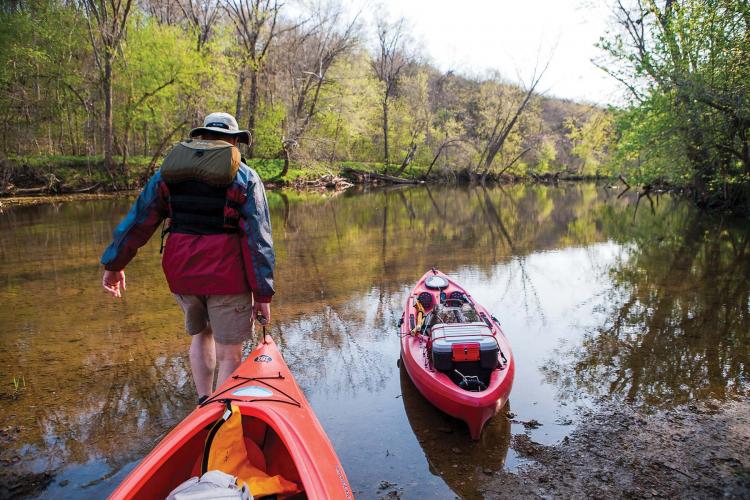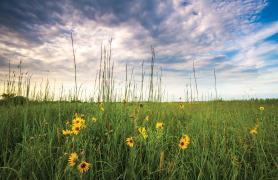When you slide a canoe into a river to start a float trip, current promptly nudges the craft downstream. Rivers are always on the move. So are the seasons in a year, with weather unleashing drastic variations in a river’s water volume, speed, and temperature. Those dynamic fluctuations trigger biological changes that enable plants, fish, frogs, and turtles to survive and thrive. Missouri’s rivers sustain a rich variety of fish and wildlife. Differences vary by ecological region.
Yet many of the ways that rivers support nature and serve people are common to all, from the murky Grand River flowing from the state’s northern prairie region, to the clear Eleven Point River draining rainfall and spring water from timber covered Ozark hills.
Fishing in a river during spring, taking a cool swim in summer, watching mallard ducks land in an eddy during autumn — all are enjoyable. All are possible because a river is linked to nature’s ceaseless changes and life cycles. As the canoe glides downstream and a paddler gazes into the water, much more is going on beneath the surface than simply water flowing over stones.
Spring: Renewal
Rivers produce a soothing, gurgling melody as water flows over riffles and around logs. It’s a song that paddlers and anglers know well. Rains control the tune and sometimes change the song into a roar. Water levels go up and down during springtime, and along with warmth from the sun, trigger changes that renew life in a river system. Spring floods reconnect a river with its floodplain.
Prairie streams like the Grand River may overflow to side channels and wetlands, providing quiet-water spawning sites for fish, egg-laying places for amphibians, and feeding places for ducks and geese winging northward toward summer breeding grounds. Rivers draining northern prairie and woodland regions, like the Grand, hold various fish year-round and are favored spots for anglers seeking channel and flathead catfish. But during a spring rise in water flow and warmer water temperatures, additional fish from the Missouri River will move into these streams looking for places to spawn, sometimes traveling many miles upstream. Male catfish will lure females into holes in the bank, hollow logs, or crevices under rocks. Then the males will fiercely guard the fertile eggs.
Large fish swimming in the Missouri, such as paddlefish, shovelnose sturgeon, and lake sturgeon, will also enter the Grand. Murky water and dirt banks conceal the fact that many prairie and woodland streams also have rocky shoals and limestone ledges bordering pools. They serve as spawning and feeding places for other fish, such as sunfish and minnows. Even angler favorites, such as white bass, sometimes make a run out of the Missouri into prairie streams. Blue suckers will move into the Grand River in large numbers to spawn on rocky shoals.
Meanwhile in the Ozark watersheds, heavy spring rains flush sediment from pools. This maintains water depth and cleans gravel beds for fish that depend on them for spawning sites. Early spring finds fish, such as walleye, migrating upstream in the Eleven Point and Current rivers to spawn in fast-water over gravel. Anglers know it’s a good time to catch big walleye at night in the deeper pools. Canoeists may also see fish like black or golden redhorse suckers gathered at favored spawning riffles.
Peer into the Eleven Point’s clear water in spring and you might see circular gravel mounds 1–3 feet in diameter and 6–8 inches high. The hornyhead chub is at work. Males excavate gravel into spawning beds during late April and early May. These 5- to 10-inch fish are known to travel 20 feet to pick up a pebble for their mound. In streams throughout the Ozarks, their handiwork also doubles as spawning beds for minnows, such as bleeding shiners, Ozark minnows, and redbelly dace.
May is a lush month in rivers as well as woodlands. Spring rains keep water flows strong. Largemouth and smallmouth bass fan out gravel nests for spawning. Canoeists may notice circular nests in quiet water near banks, side channels, and shallows, likely made by orangespotted sunfish in northern streams and longear sunfish in the south. Insects, tadpoles, and young crayfish emerge from hiding places.
The wetted side channels and shallows curl around sand bars and snags, providing a place for water willow to grow. Vegetation provides nursery habitat for young fish and a critical food supply for aquatic insects. Northern cricket frogs attach their eggs to the vegetation, too. Spring also brings young beavers and river otters from their lodges and dens. All these things a canoeist may see on a spring day. But like fluffy white cottonwood seed landing on water and floating downstream, all they see will soon change.
Summer: Sun and Storms
Rivers are havens for people during Missouri’s hot, dry summers. Whether it’s a scenic float trip down the Eleven Point, fishing for smallmouth bass on the Gasconade, chasing catfish on the Grand River, or just spending the afternoon splashing in a favorite swimming hole, Missourians spend a lot of time using and enjoying our rivers and streams in summer.
Summer finds river flows lower but also steadier, which has specific benefits for fish and wildlife. Many species use changes caused by lower water flows to complete their life cycle. Wetlands slowly drain into the rivers, which allow growth of wetland vegetation that will provide food for ducks, geese, and shorebirds migrating southward in winter. In larger rivers, species like the eastern spiny softshell turtle search for exposed sandbars and gravel bars to lay their eggs.
Many a person wading in a stream on a summer day has pulled up a freshwater mussel, studied the oval shell, and placed it back in the water. They may have interrupted a reproductive liaison. Freshwater mussel species, such as the plain pocketbook, use this time to complete their life cycle.
The plain pocketbook waves a piece of flesh that acts as a lure to attract potential fish hosts for their young. When a potential host fish takes the bait, instead of getting something to eat, they get a face full of microscopic glochidia, larval mussels. Glochidia attach to fish gills, grow and transform, then in late summer or early autumn they fall off the unharmed fish and begin life as a bottom-dwelling mussel. Completing this cycle during summer’s lower, steady river flows helps maximize chances the young mussels will land in a place that will stay wet year-round and survive.
The dry season causes uncertain survival for many species in smaller streams where water flows cease and only pools remain. These isolated pools serve as refuge for aquatic species and critical water supplies for many terrestrial species. Their salvation is that weather, like nature, is always changing.
Thunderstorms send canoeists and anglers scrambling for shelter. But summer storms are a saving grace for small streams. They play a crucial role in maintaining and recharging pools by reducing water temperatures and enhancing water quality, allowing species to survive until the season turns and steady flows return.
Fall: Returns
Autumn rains bring rivers cooler water temperatures and healthier flows. Scarlet, purple, and golden leaves drop from trees to the water and are carried downstream, unless they pile up on a log jam and provide temporary cover for fish. Anglers enjoy rivers in autumn because the fish are often biting as they store energy for winter. And if the fish are not hungry, the scenery is gorgeous.
When fall rains push rivers out of their banks, wetlands are recharged. Shallow side channels that went bare in summer now fill with water again. Great blue herons and shore birds have more places to stalk small fish or hunt aquatic bugs. Blue-winged and green-winged teal are the first migrating waterfowl to visit the pools of Missouri’s rivers and wetlands. But pelicans, shorebirds, ducks, and geese follow as autumn turns colder and daylight grows shorter.
It may not be obvious to the fall paddler, but fish are on the move, too. Flathead and blue catfish move to deeper pools, perhaps even move out of rivers like the Grand back into deep pools of the Missouri River. In Ozark rivers like the Eleven Point, smallmouth bass move toward winter haunts in the larger springs, taking advantage of steady water temperature.
Autumn’s cooler water and shorter days trigger the reproductive season for some river species. Missouri’s largest salamander, the hellbender, gathers in deep pools in Ozark streams to breed. Females lay their eggs in cavities under large rocks, and the males remain to defend the eggs until they hatch a month later. Many crayfish, too, such as golden crayfish and Ozark crayfish, breed during fall and the females carry the eggs until the following spring.
Water flowing in a river is always headed for the next bend or riffle, and a stream’s creatures are always preparing for the next season.
Winter: Rest
Winter’s return slows biological life in a river but never completely halts growth and changes. Folks in the Ozarks may take advantage of clear water and low flows to gig suckers and hold onshore fish-fry gatherings. Birders hiking near northern rivers watch for migrating eagles fishing in rivers like the Grand. A hard freeze might trap and kill shad, and eagles will feast on them during a thaw. Many fish, turtles, crayfish, and other aquatic species spend most of the winter in a single deep pool, moving and eating very little. They rely on steady river flows to maintain their winter habitats, whether it’s in open water or under a layer of ice.
A prolonged cold snap will freeze the surface of most lakes and wetlands. But moving water keeps rivers at least partially open as resting and feeding habitat for waterfowl that linger late into winter. And no matter the cold, river otter breeding occurs over several months starting in December. Their pregnancies last about a year, so birth will occur in the cold season.
Missouri winters fade in late February and early March. Spring rains, longer hours of sunlight, and warming water temperatures prompt walleye once again to swim upstream to rocky riffles and spawn. Big-river catfish are on the move. Aquatic insects hatch and minnows eat them. Paddlers spot great blue herons wading in the shallows to eat minnows.
The river’s seasonal cycles begin again, change never ending for the life within.






















Also In This Issue


And More...
This Issue's Staff
Associate Editor - Bonnie Chasteen
Staff Writer - Larry Archer
Staff Writer - Heather Feeler
Staff Writer - Kristie Hilgedick
Staff Writer - Joe Jerek
Creative Director - Stephanie Thurber
Art Director - Cliff White
Designer - Les Fortenberry
Designer - Marci Porter
Photographer - Noppadol Paothong
Photographer - David Stonner
Circulation - Laura Scheuler






















